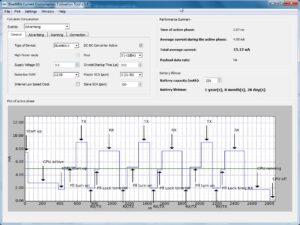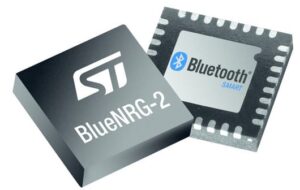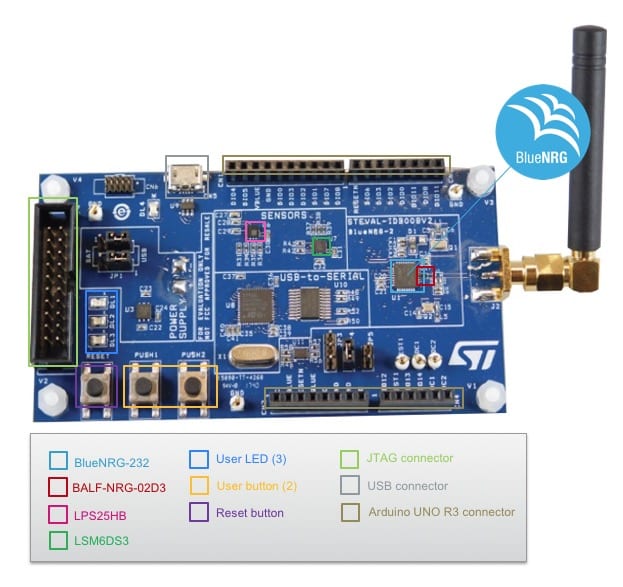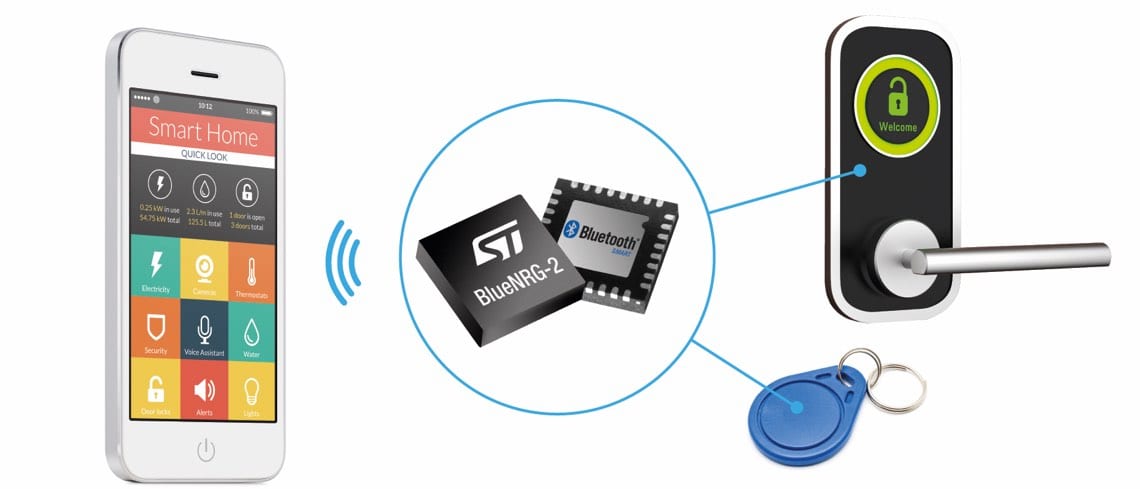Read our article on the BlueNRG-2N, a processor with the same feature-set of the BlueNRG-2, but without the MCU for lower power consumption and an out-of-the-box firmware.
As the world raves about Bluetooth mesh, the IoT solution connecting thousands of small devices together, one thing becomes apparent: those that invested in ST’s Bluetooth SoC are part of the “lucky few” that can already transition to the new standard with just a simple firmware update. It was thus essential to dive deeper into our latest flagship SoC that accepts this update, the BlueNRG–2, officially launched about a year ago, to better understand the technical considerations that went into it and why it’s been so popular. Just like the BlueNRG–1 before it, the latest SoC uses a Cortex-M0 core and 24 kB of RAM. However, the newest model integrates more flash memory (256 kB vs. 160 kB) and is compliant with the Bluetooth 5 standard.
Webinar: 1-hour webinar on how to build secure Bluetooth mesh networks with the new BlueNRG-Mesh SDK
Features
Bluetooth 5 is starting to gain traction within the industry and companies looking to future-proof their design must figure out whether adopting it makes sense to them. On the other side of the aisle, manufacturers must select the features they will implement to get the Bluetooth 5 certification. Indeed, the protocol itself is very far-reaching and companies traditionally focus on the functionalities that best serve the applications they are targeting. For ST, this first meant a pin-to-pin compatibility between our BlueNRG-1 and BlueNRG-2 SoC. It was fundamental for us to ensure that engineers had the possibility to easily switch between the two with very little changes to the code base to help them determine which solution made the most sense for their design.
Our teams also added three major features in the BlueNRG-2 SoC (Data Length Extension, Secure Connection, and Bluetooth Smart privacy 1.2) to get a Bluetooth 5 certification, while also remaining pertinent to our core customers that primarily use our component for IoT applications.
Faster and More Practical

Indeed, our SoC focuses on low-power application. With an average advertisement current consumption of only 15.12 µA, a device can last one year, eight months, and 28 days on a simple 230 mAh coin cell CR2032 battery, if advertising operations take place once every second. However, our engineers still improved the radio and its performance to support Data Length Extension.
When compared to the BlueNRG–1, the improvement is significant because the support for the Data Length Extension increases bandwidth from 200 kbps to 600 kbps in the new SoC. It did require a silicon redesign of the radio’s MAC layer, and we also updated our software stack so developers could rapidly take advantage of it, which proved especially useful as they took advantage of the extra bandwidth to more easily implement Over-The-Air updates. Similarly, another hardware improvement is the availability of a QFN48 package that offers 26 programmable GPIOs to developers instead of 15 with the previous QFN32 package, which allows them to better optimize the way they use the latest SoC. The GPIO configuration table is available in the SoC’s main documentation.
Securing Bluetooth 5

We also work on securing connections and data transfers. Hence, the Low Energy mode of the BlueNRG–2 is now compatible with Secure Connection, the new FIPS compliant encryption mode adopted by the Bluetooth SIG (Special Interest Group). The Federal Information Processing Standards come from the American National Institute of Standards and Technology (NIST) and comply with the Federal Information Security Management ACT. In this case, the new standards protect against key sniffing, a technique that a hacker could use to steal encryption keys shared for the first time when devices are paired. BlueNRG–2 also integrates specific hardware to accelerate ECC-256 and AES–128 CCM mode (Counter with CBC-MAC) cryptographic operations to optimize performance and increase the robustness of the implementation against low-level attacks. Ultimately, this means that we go beyond a traditional integration of Bluetooth SIG standards to enhance the safety of our customer’s data.
Bluetooth Smart privacy 1.2 is also part of the BlueNRG-2 to prevent hackers from tracking the user’s MAC address. Very simply, a MAC address is similar to a serial number for your Ethernet, Wi-Fi, or Bluetooth module, among others, and since it is unique to your device, people can track your MAC address when you connect to a Wi-Fi Access Point, or when you pair a device with your car or smartphone, to potentially follow your movements. Bluetooth Smart privacy prevents inappropriate intrusions in the user’s privacy by replacing the Bluetooth MAC address with a randomized value that changes at regular intervals or after a specific event, such as turning a device on and off, making it impossible to keep track a person’s movements through their Bluetooth devices.
Creating Bluetooth 5 Devices Today
The easiest way to start prototyping with the BlueNRG–2 is to get the STEVAL-IDB008V2 expansion board, which also integrates ST’s baluns (BALF-NRG-02D3). The board also includes a 3D digital accelerometer and gyroscope (LSM6DS3), as well as a pressure sensor with an embedded thermometer (LPS25HB) to help developers start their IoT applications.
Finally, alongside the STSW-BNRG-Mesh package mentioned above, the STEVAL-IDB008V2 is compatible with a software package, the STSW-BLUENRG1-DK, that contains drivers, a radio initialization wizard, libraries, and application examples for BlueNRG–1 and BlueNRG-2, simplifying even further the development process. This will help anyone with a basic understanding of RF generate the right configuration files. Engineers can also look at our implementations and customize them to their needs. A flashing utility then programs the SoC using the UART bootloader. It also means that developers can keep most of their code when transitioning from our board to a custom PCB, as long as they follow a similar design.

